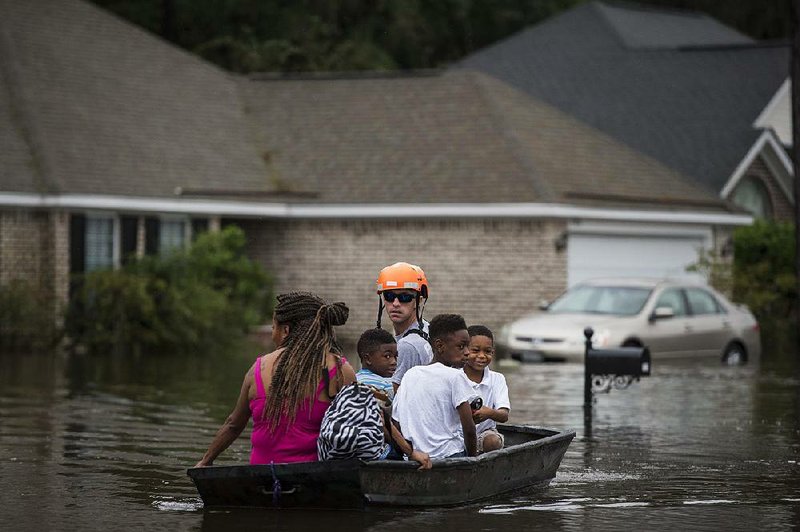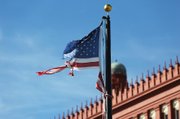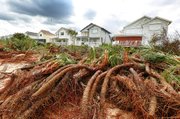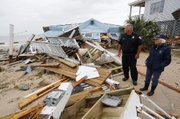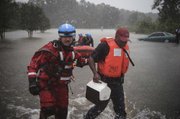CHARLESTON, S.C. -- A weakening Hurricane Matthew lashed Georgia and the Carolinas on Saturday in what appeared to be the last leg of its march up the East Coast, leaving in its wake millions of Americans who had feared much worse.
RELATED ARTICLE
http://www.arkansas…">In Haiti, a daily struggle
The hurricane was blamed for at least 10 deaths in the U.S., including that of a 68-year-old Georgia man who died when two trees fell on his home.
By Saturday night, North Carolina felt the brunt of Matthew, with more than a foot of rain falling in the southeastern part of the state, causing life-threatening flash flooding, forecasters said. Homes, businesses and roads as far west as Raleigh, about 140 miles from the coast, also were damaged by the deluge.
But in many places along the Southeast coast, the damage consisted mostly of flooded streets, blown-down signs and awnings, flattened trees and power failures.
[ MATTHEW’S IMPACT: Map of power outages, shelters]
[HURRICANE TRACKER: Follow Hurricane Matthew’s path so far]
As the storm passed and the skies cleared, many people already were cleaning up, reopening businesses or hitting the beach. The power started returning. And all three major theme parks in Orlando, Fla., including Walt Disney World, were up and running.
"We are all blessed that Matthew stayed off our coast," Florida Gov. Rick Scott said. "We are blessed that we didn't have a direct hit."
On Saturday, Matthew sideswiped two of the South's oldest and most historic cities -- Savannah, Ga., and Charleston, S.C. -- and also delivered torrential rain and stiff winds to places such as Myrtle Beach, S.C., and Wilmington, N.C.
From there, it was expected to veer out to sea, lose steam and loop back around toward the Bahamas and Florida, too feeble to cause any trouble.
[WATCH: Video shows plane flying into eye of Hurricane Matthew]
For nearly its entire run up the coast from Florida, Matthew hung just far enough offshore that communities did not feel the full force of its winds.
The storm finally made landfall Saturday morning near McClellanville, S.C., about 30 miles northeast of Charleston, as a Category 1 hurricane, with winds of 75 mph.
Matthew's deadly potential was made all too clear in Haiti, where the hurricane roared ashore Tuesday with terrifying 145 mph winds.
For the United States, the hurricane seemed destined to be remembered mostly as an enormous inconvenience rather than a catastrophe. Authorities repeatedly urged residents who were advised to evacuate not to rush back to their homes.
"When the storm hits, you're praying -- and then now the frustration sets in," said Gov. Nikki Haley of South Carolina. "And what I am going to ask for you is patience. Most injuries, most fatalities, occur after a storm because people attempt to move in too soon."
While Matthew's wind speed had dropped considerably by the time it hit the Southeast coast, the storm still will go down as one of the most potent hurricanes on record, based on such factors as wind energy and longevity, and as one of the most long-lived major hurricanes.
It was a major hurricane -- that is, with winds of at least 110 mph -- for 7.25 days.
The storm swamped the streets of Savannah, a historic town of moss-draped squares and antebellum mansions. A homeless woman was seen staggering through waters up to her neck. She made it across safely.
A Coast Guard helicopter crew also rescued a man stranded on a sailboat in a river near Georgia's Tybee Island. And North Carolina officials said they had to rescue numerous people from cars and homes.
The streets of Charleston -- a city of pre-Civil War homes, church steeples and romantic carriage rides -- also were flooded in what officials said was the strongest storm to hit the Charleston area since Hurricane Hugo in 1989.
"It's not as bad as maybe I was expecting," said Leigh Webber, who watched from her porch in the city's historic district.
"I feel badly for a lot of the businesses downtown that have been closed since Wednesday," she added. "I noticed a lot of hotels were completely closed. I know some weddings were canceled and it was a huge financial loss for a lot of people."
Property data firm CoreLogic projected the storm would cause $4 billion to $6 billion in insured losses on home and commercial properties in Florida, Georgia and the Carolinas. That compares with Hurricane Katrina's $40 billion and superstorm Sandy's $20 billion.
South Carolina's golf-and-tennis resort Hilton Head Island also took a blow as the eye of the storm passed 20 miles to the east. At least one gust of 87 mph was recorded at Hilton Head.
The two roads onto the island of 40,000 people were blocked by fallen pine trees, and many roads were under water.
All access points to Georgia's St. Simons Island from the mainland were blocked. Tybee Island also took a beating, with gusts clocked at 93 mph.
About 1 million people in Florida lost power. Three-quarters of a million people in South Carolina were left without electricity, and 250,000 were in the dark in coastal Georgia.
At the Baymont Inn and Suites in Statesboro, Ga., all 92 rooms were booked, mostly with coastal residents, even though the hotel had no power.
"It's annoying, but we're safe," said Rayma Griffin, 68, an evacuee from Fripp Island, who was leaving the hotel to go farther inland for a place with electricity. "I just hope when we get home we find a roof over our heads."
Nicole Potts, a clerk at the hotel, said that while people were generally safe and sound, the aggravations -- no power, a shortage of toilet paper -- were growing.
"And it's a dry county," she said. "All of these people are having to deal with this sober."
Four deaths were blamed on the storm in Florida, three in Georgia and three in North Carolina. The deaths included an elderly Florida couple who died from carbon monoxide fumes while running a generator in their garage and two women who were killed when trees fell on a home and a camper.
The storm raked yet another historic Southern city on its way up the coast: St. Augustine, Fla., which was founded by the Spanish in the 1500s and includes many historic homes. The city was left awash in rain and gray seawater Friday.
Property manager Nick Trunck went to check on several stores and apartments. He said the damage consisted of little more than several lost shingles, a lost awning and water seeping into one area.
Trunck had arranged for 10 men to travel from Connecticut to help with the cleanup, but after getting a look at the damage, he said he could probably get by with "a couple of guys and a mop."
The center of the storm barely missed Cape Canaveral, Fla., and did no significant damage to the nation's most important launch infrastructure for civilian and military spacecraft.
President Barack Obama had declared emergencies in Florida, Georgia and the Carolinas. An estimated 2 million people in the Southeast were ordered to evacuate as Matthew closed in.
The Drudge Report and other online media outlets suggested that weather forecasters and mainstream news organizations overhype the evacuation orders and hazards from hurricanes. But analysts said the forecasts for Matthew's size and strength were accurate, though hurricanes rarely follow a script.
By hugging the coast, the storm pretty much behaved as forecasters predicted.
Despite the evacuation orders in Florida, countless people rode out the storm, including Keith Kokesh of Ormond Beach, just north of Daytona Beach, who feared looters if he fled.
"My son has every video-game system there is, and I don't want to lose it," Kokesh said.
Jim Dinneen -- manager of Volusia County, which includes Ormond Beach and Daytona Beach -- said he was thankful that Matthew had stayed roughly 30 miles offshore.
"I don't think 30 miles has ever meant so much to a community," he said.
Information for this article was contributed by Holbrook Mohr, Gary Fineout, Kelli Kennedy, Terry Spencer, Jennifer Kay, Freida Frisaro, Curt Anderson, Marcia Dunn, Janelle Cogan, Russ Bynum, Martha Waggoner, Jeffrey Collins, Jack Jones, Meg Kinnard, Bruce Smith and Russ Bynum of The Associated Press; by Jess Bidgood, Alan Blinder, Richard Perez-Pena, Lizette Alvarez, Nick Madigan, Les Neuhaus, Campbell Robertson and Frances Robles of The New York Times; and by Dustin Waters, Arelis R. Hernandez, Renae Merle, Joel Achenbach, William Branigin, Mark Berman, Angela Fritz, Jason Samenow, Lacey McLaughlin, Lori Rozsa, Susan Cooper Eastman, Sharon Dunten, Camille Pendley, Kirk Ross, Francisco Alvarado and Tal Abbady of The Washington Post.
A Section on 10/09/2016
